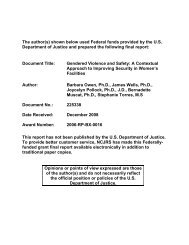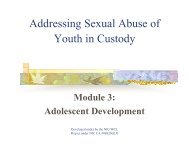The Impact of Incarcerating Youth in Detention and Other Secure ...
The Impact of Incarcerating Youth in Detention and Other Secure ...
The Impact of Incarcerating Youth in Detention and Other Secure ...
You also want an ePaper? Increase the reach of your titles
YUMPU automatically turns print PDFs into web optimized ePapers that Google loves.
A Justice Policy Institute ReportBy Barry Holman <strong>and</strong> Jason Ziedenberg<strong>The</strong> Dangers <strong>of</strong> <strong>Detention</strong>:<strong>The</strong> <strong>Impact</strong> <strong>of</strong> <strong>Incarcerat<strong>in</strong>g</strong> <strong>Youth</strong> <strong>in</strong> <strong>Detention</strong> <strong>and</strong> <strong>Other</strong> <strong>Secure</strong> Facilities
<strong>The</strong> Dangers <strong>of</strong> <strong>Detention</strong>:<strong>The</strong> <strong>Impact</strong> <strong>of</strong> <strong>Incarcerat<strong>in</strong>g</strong> <strong>Youth</strong> <strong>in</strong> <strong>Detention</strong> <strong>and</strong> <strong>Other</strong> <strong>Secure</strong> FacilitiesA Justice Policy Institute Reportby Barry Holman <strong>and</strong> Jason Ziedenberg1
<strong>The</strong> Dangers <strong>of</strong> <strong>Detention</strong> 1Introduction: <strong>The</strong> Grow<strong>in</strong>g <strong>Impact</strong> <strong>of</strong> <strong>Youth</strong> <strong>Detention</strong>Despite the lowest youth crime rates <strong>in</strong> 20 years, hundreds <strong>of</strong> thous<strong>and</strong>s <strong>of</strong> youngpeople are locked away every year <strong>in</strong> the nation’s 591 secure detention centers.<strong>Detention</strong> centers are <strong>in</strong>tended to temporarily house youth who pose a high risk <strong>of</strong>re-<strong>of</strong>fend<strong>in</strong>g before their trial, or who are deemed likely to not appear for their trial.But the nation’s use <strong>of</strong> detention is steadily ris<strong>in</strong>g, <strong>and</strong> facilities are packed with youngpeople who do not meet those high-risk criteria—about 70 percent are deta<strong>in</strong>ed fornonviolent <strong>of</strong>fenses. 2“[F]airly viewed,pretrial detention <strong>of</strong> ajuvenile gives rise to<strong>in</strong>juries comparable tothose associated withthe imprisonment <strong>of</strong>an adult.”–Justice Marshall forthe m<strong>in</strong>ority <strong>in</strong> Schall v.Mart<strong>in</strong>, 1984.“<strong>Detention</strong>: A form <strong>of</strong> locked custody <strong>of</strong> youth pre-trial who are arrested—juvenile detention centers are the juvenile justice system’s version <strong>of</strong>“jail,” <strong>in</strong> which most young people are be<strong>in</strong>g held before the court hasjudged them del<strong>in</strong>quent. Some youth <strong>in</strong> detention are there because theyfail the conditions <strong>of</strong> their probation or parole, or they may be wait<strong>in</strong>g<strong>in</strong> detention before their f<strong>in</strong>al disposition (i.e. sentence to a communityprogram, or juvenile correctional facility).” 3<strong>The</strong> <strong>in</strong>creased <strong>and</strong> unnecessary use <strong>of</strong> secure detention exposes troubled youngpeople to an environment that more closely resembles adult prisons <strong>and</strong> jails thanthe k<strong>in</strong>ds <strong>of</strong> community <strong>and</strong> family-based <strong>in</strong>terventions proven to be most effective.<strong>Detention</strong> centers, said a former Deputy Mayor <strong>of</strong> New York <strong>of</strong> that city’s <strong>in</strong>famousSp<strong>of</strong>ford facility, are “<strong>in</strong>dist<strong>in</strong>guishable from a prison.” 4 Comment<strong>in</strong>g on New York’sdetention centers, one Supreme Court Justice said that, “fairly viewed, pretrialdetention <strong>of</strong> a juvenile gives rise to <strong>in</strong>juries comparable to those associated with theimprisonment <strong>of</strong> an adult.” 5Deta<strong>in</strong>ed youth, who are frequently pre-adjudication <strong>and</strong> await<strong>in</strong>g their court date,or sometimes wait<strong>in</strong>g for their placement <strong>in</strong> another facility or community-basedprogram, can spend anywhere from a few days to a few months <strong>in</strong> locked custody. Atbest, deta<strong>in</strong>ed youth are physically <strong>and</strong> emotionally separated from the families <strong>and</strong>communities who are the most <strong>in</strong>vested <strong>in</strong> their recovery <strong>and</strong> success. Often, deta<strong>in</strong>edyouth are housed <strong>in</strong> overcrowded, understaffed facilities—an environment that conspiresto breed neglect <strong>and</strong> violence.A recent literature review i <strong>of</strong> youth corrections shows that detention has a pr<strong>of</strong>oundlynegative impact on young people’s mental <strong>and</strong> physical well-be<strong>in</strong>g, their education,<strong>and</strong> their employment. One psychologist found that for one-third <strong>of</strong> <strong>in</strong>carcerated youthdiagnosed with depression, the onset <strong>of</strong> the depression occurred after they began their<strong>in</strong>carceration, 6 <strong>and</strong> another suggests that poor mental health, <strong>and</strong> the conditions <strong>of</strong>conf<strong>in</strong>ement together conspire to make it more likely that <strong>in</strong>carcerated teens will engage<strong>in</strong> suicide <strong>and</strong> self-harm. 7 Economists have shown that the process <strong>of</strong> <strong>in</strong>carcerat<strong>in</strong>g youthwill reduce their future earn<strong>in</strong>gs <strong>and</strong> their ability to rema<strong>in</strong> <strong>in</strong> the workforce, <strong>and</strong> couldchange formerly deta<strong>in</strong>ed youth <strong>in</strong>to less stable employees. Educational researchershave found that upwards <strong>of</strong> 40 percent <strong>of</strong> <strong>in</strong>carcerated youth have a learn<strong>in</strong>g disability,<strong>and</strong> they will face significant challenges return<strong>in</strong>g to school after they leave detention.Most importantly, for a variety <strong>of</strong> reasons to be explored, there is credible <strong>and</strong> significantresearch that suggests that the experience <strong>of</strong> detention may make it more likely that2
<strong>The</strong> <strong>Impact</strong> <strong>of</strong> <strong>Detention</strong>on Crime, Rehabilitation, <strong>and</strong> Public Safety<strong>Detention</strong> can <strong>in</strong>crease recidivismInstead <strong>of</strong> reduc<strong>in</strong>g crime, the act <strong>of</strong> <strong>in</strong>carcerat<strong>in</strong>g high numbers <strong>of</strong> youth may <strong>in</strong> factfacilitate <strong>in</strong>creased crime by aggravat<strong>in</strong>g the recidivism <strong>of</strong> youth who are deta<strong>in</strong>ed.A recent evaluation <strong>of</strong> secure detention <strong>in</strong> Wiscons<strong>in</strong>, conducted by the state’s Jo<strong>in</strong>tLegislative Audit Committee reported that, <strong>in</strong> the four counties studied, 70 percent <strong>of</strong>youth held <strong>in</strong> secure detention were arrested or returned to secure detention with<strong>in</strong> oneyear <strong>of</strong> release. 10 <strong>The</strong> researchers found that “placement <strong>in</strong> secure detention may detera small proportion <strong>of</strong> juveniles from future crim<strong>in</strong>al activity, although they do not determost juveniles.”Prior Incarceration was a Greater Predictor <strong>of</strong> Recidivism thanCarry<strong>in</strong>g a Weapon, Gang Membership, or Poor Parental Relationship141210813.563.340.6 2.020Poor ParentalRelationshipMembership<strong>in</strong> GangCarry<strong>in</strong>g aWeaponPriorCommitmentPredictors <strong>of</strong> RecidivismSource: Benda, B.B. <strong>and</strong> Tollet, C.L. (1999), “A Study <strong>of</strong> Recidivism <strong>of</strong> Serious<strong>and</strong> Persistent Offenders Among Adolescents.” Journal <strong>of</strong> Crim<strong>in</strong>al Justice, Vol. 27, No. 2 111-126.Studies on Arkansas’ <strong>in</strong>carcerated youth 11 found not only a high recidivism rate for<strong>in</strong>carcerated young people, but that the experience <strong>of</strong> <strong>in</strong>carceration is the mostsignificant factor <strong>in</strong> <strong>in</strong>creas<strong>in</strong>g the odds <strong>of</strong> recidivism. Sixty percent <strong>of</strong> the youthstudied were returned to the Department <strong>of</strong> <strong>Youth</strong> Services (DYS) with<strong>in</strong> three years.<strong>The</strong> most significant predictor <strong>of</strong> recidivism was prior commitment; the odds <strong>of</strong>return<strong>in</strong>g to DYS <strong>in</strong>creased 13.5 times for youth with a prior commitment. Amongthe youth <strong>in</strong>carcerated <strong>in</strong> Arkansas, two-thirds were conf<strong>in</strong>ed for nonviolent <strong>of</strong>fenses.Similarly, the crimes that l<strong>and</strong>ed the serious <strong>of</strong>fenders under the supervision <strong>of</strong> adultcorrections were overwhelm<strong>in</strong>gly nonviolent—less than 20 percent were crimesaga<strong>in</strong>st persons.4
Congregat<strong>in</strong>g del<strong>in</strong>quent youth together negatively affects their behavior<strong>and</strong> <strong>in</strong>creases their chance <strong>of</strong> re-<strong>of</strong>fend<strong>in</strong>gBehavioral scientists are f<strong>in</strong>d<strong>in</strong>g that br<strong>in</strong>g<strong>in</strong>g youth together for treatment or servicesmay make it more likely that they will become engaged <strong>in</strong> del<strong>in</strong>quent behavior. Nowhereare deviant youth brought together <strong>in</strong> greater numbers <strong>and</strong> density than <strong>in</strong> detentioncenters, tra<strong>in</strong><strong>in</strong>g schools, <strong>and</strong> other conf<strong>in</strong>ed congregate “care” <strong>in</strong>stitutions.Researchers at the Oregon Social Learn<strong>in</strong>g Center found that congregat<strong>in</strong>g youthtogether for treatment <strong>in</strong> a group sett<strong>in</strong>g causes them to have a higher recidivismrate <strong>and</strong> poorer outcomes than youth who are not grouped together for treatment.<strong>The</strong> researchers call this process “peer deviancy tra<strong>in</strong><strong>in</strong>g,” <strong>and</strong> reported statisticallysignificant higher levels <strong>of</strong> substance abuse, school difficulties, del<strong>in</strong>quency, violence,<strong>and</strong> adjustment difficulties <strong>in</strong> adulthood for those youth treated <strong>in</strong> a peer group sett<strong>in</strong>g.<strong>The</strong> researchers found that “un<strong>in</strong>tended consequences <strong>of</strong> group<strong>in</strong>g children at-riskfor externaliz<strong>in</strong>g disorders may <strong>in</strong>clude negative changes <strong>in</strong> attitudes toward antisocialbehavior, affiliation with antisocial peers, <strong>and</strong> identification with deviancy.” 12<strong>Detention</strong> pulls youth deeper <strong>in</strong>to the juvenile <strong>and</strong> crim<strong>in</strong>al justice system“Lock<strong>in</strong>g up kids is theeasiest way. But oncethey get <strong>in</strong> the juvenilejustice system, it’s veryhard to get them out.”Similar to the comment by the San Jose police chief, studies have shown that onceyoung people are deta<strong>in</strong>ed, even when controll<strong>in</strong>g for their prior <strong>of</strong>fenses, they are morelikely than non-deta<strong>in</strong>ed youth to end up go<strong>in</strong>g “deeper” <strong>in</strong>to the system; these studiesshow that deta<strong>in</strong>ed youth are more likely to be referred to court, see their case progressthrough the system to adjudication <strong>and</strong> disposition, have a formal disposition filed aga<strong>in</strong>stthem, <strong>and</strong> receive a more serious disposition.Deta<strong>in</strong>ed <strong>Youth</strong> Are More Likely to:—San Jose Police ChiefBill L<strong>and</strong>sdowne 13 9.0%6 .2 %8.0%7.0%6.0%5.0%4.0%3.0%2.0%1.0%0.0%Have a petitionfiled at <strong>in</strong>take9 .0 %Have a petitionfiled by thestate’s attorney8 .5 %Receive formaljudicial<strong>in</strong>terventionSource: Frazier, C.E. <strong>and</strong> Cochran, J.K. (1986) <strong>Detention</strong> <strong>of</strong> Juveniles: Its Effects on Subsequent Juvenile Court Process<strong>in</strong>g <strong>and</strong> Decisions. <strong>Youth</strong><strong>and</strong> Society, Vol. 17, No. 3, March 1986, p. 286-305 (N=9,317; p=.05)A study done <strong>in</strong> Florida <strong>in</strong> the late 1980s found that, when controll<strong>in</strong>g for other keyvariables such as age, race, gender, <strong>and</strong> <strong>of</strong>fense severity, deta<strong>in</strong>ed youth faced a greaterprobability <strong>of</strong> hav<strong>in</strong>g a petition filed at <strong>in</strong>take (6.2 percent), a greater probability for hav<strong>in</strong>ga petition filed by the State Attorney (9 percent), <strong>and</strong> a greater probability <strong>of</strong> receiv<strong>in</strong>gformal judicial <strong>in</strong>terventions (8.5 percent) than youth not deta<strong>in</strong>ed. Another study <strong>in</strong>Florida by the Office <strong>of</strong> State Court Adm<strong>in</strong>istrators found that when controll<strong>in</strong>g for otherfactors—<strong>in</strong>clud<strong>in</strong>g severity <strong>of</strong> <strong>of</strong>fense—youth who are deta<strong>in</strong>ed are three times morelikely to end up be<strong>in</strong>g committed to a juvenile facility than similar youth who are notdeta<strong>in</strong>ed. 145
Alternatives to detention can curb crime <strong>and</strong> recidivism better than detentionSeveral studies have shown that youth who are <strong>in</strong>carcerated are more likely to recidivatethan youth who are supervised <strong>in</strong> a community-based sett<strong>in</strong>g, or not deta<strong>in</strong>ed at all.Young people <strong>in</strong> San Francisco’s <strong>Detention</strong> Diversion Advocacy Program, for example,have about half the recidivism rate <strong>of</strong> young people who rema<strong>in</strong>ed <strong>in</strong> detention or <strong>in</strong> thejuvenile justice system. 15Various Measures <strong>of</strong> Recidivism between <strong>Detention</strong> <strong>and</strong> Diversion60%Research from Floridashows that whencontroll<strong>in</strong>g for otherfactors, youth whoare deta<strong>in</strong>ed arethree times morelikely to end up be<strong>in</strong>gcommitted to a juvenilefacility than similaryouth who are notdeta<strong>in</strong>ed.Recidivism PercentageDDAPCo mparison50%40%30%20%10%0%34% 60% 14% 50% 9% 25% 5% 22%OverallRecidivismTwo or MoreSubsequentReferralsReturned to Courtfor Violent Crime<strong>Youth</strong> <strong>in</strong> DDAP or Comparison GroupTwo or MoreSubsequentPetitionsSource: Sheldon, R.G. (1999), “<strong>Detention</strong> Diversion Advocacy: An Evaluation.” Juvenile Justice Bullet<strong>in</strong>Wash<strong>in</strong>gton, DC: Department <strong>of</strong> Justice, Office <strong>of</strong> Juvenile Justice <strong>and</strong> Del<strong>in</strong>quency Prevention(DDAP n=271; Comparison n=271)Research from Texas suggests that young people <strong>in</strong> community-based placements are 14percent less likely to commit future crimes than youth that have been <strong>in</strong>carcerated. 16<strong>Detention</strong> can slow or <strong>in</strong>terruptthe natural process <strong>of</strong> “ag<strong>in</strong>g out <strong>of</strong> del<strong>in</strong>quency”Many young people <strong>in</strong> fact engage <strong>in</strong> “del<strong>in</strong>quent” behavior, but despite high<strong>in</strong>carceration rates, not all youth are deta<strong>in</strong>ed for del<strong>in</strong>quency. Dr. Delbert Elliott,former President <strong>of</strong> the American Society <strong>of</strong> Crim<strong>in</strong>ology <strong>and</strong> head <strong>of</strong> the Center forthe Study <strong>of</strong> the Prevention <strong>of</strong> Violence has shown that as many as a third <strong>of</strong> youngpeople will engage <strong>in</strong> del<strong>in</strong>quent behavior 17 before they grow up but will naturally “ageout” <strong>of</strong> the del<strong>in</strong>quent behavior <strong>of</strong> their younger years. While this rate <strong>of</strong> del<strong>in</strong>quencyamong young males may seem high, the rate at which they end their crim<strong>in</strong>al behavior,(called the “desistance rate”) is equally high. 18 Most youth will desist from del<strong>in</strong>quencyon their own. For those who have more trouble, Elliott has shown that establish<strong>in</strong>ga relationship with a significant other (a partner or mentor) as well as employmentcorrelates with youthful <strong>of</strong>fenders <strong>of</strong> all races “ag<strong>in</strong>g out” <strong>of</strong> del<strong>in</strong>quent behavior asthey reach young adulthood.6
Most Young People Age Out <strong>of</strong> Crime on <strong>The</strong>ir Own6 0 0 0Crime Rates by AgeArrest Rates (per 100,000)5 0 0 04 0 0 03 0 0 02 0 0 01 0 0 00< 1 2 1 3 - 1 4 1 6 1 8 2 0 2 2 2 4 2 5 - 2 9 3 0 - 3 4Age (years)Source: FBI Crime <strong>in</strong> the United States (1993).<strong>The</strong>re is little observedrelationship betweenthe <strong>in</strong>creased use <strong>of</strong>detention, <strong>and</strong> crime.Whether a youth is deta<strong>in</strong>ed or not for m<strong>in</strong>or del<strong>in</strong>quency has last<strong>in</strong>g ramifications forthat youth’s future behavior <strong>and</strong> opportunities. Carnegie Mellon researchers have shownthat <strong>in</strong>carcerat<strong>in</strong>g juveniles may actually <strong>in</strong>terrupt <strong>and</strong> delay the normal pattern <strong>of</strong> “ag<strong>in</strong>gout” s<strong>in</strong>ce detention disrupts their natural engagement with families, school, <strong>and</strong> work. 19<strong>The</strong>re is little relationship betweendetention <strong>and</strong> overall crime <strong>in</strong> the communityWhile there may be an <strong>in</strong>dividual need to <strong>in</strong>carcerate some high-risk youth, the massdetention <strong>of</strong> a half-million youth each year is not necessarily reduc<strong>in</strong>g crime.Dur<strong>in</strong>g the first part <strong>of</strong> the 1990s, as juvenile arrests rose, the use <strong>of</strong> detention rosefar faster (See table, “Different Directions”). By the middle <strong>of</strong> the 1990s, as juvenilearrests began to plummet (<strong>and</strong> the number <strong>of</strong> youth aged 10-17 leveled <strong>of</strong>f), the use <strong>of</strong>detention cont<strong>in</strong>ued to rise. In other words, while there may be some youth who needto be deta<strong>in</strong>ed to protect themselves, or the public, there is little observed relationshipbetween the <strong>in</strong>creased use <strong>of</strong> detention, <strong>and</strong> crime.Different Directions:<strong>Detention</strong> Populations vs. Arrest Rates for U.S. Juveniles <strong>in</strong> the 1990sDIFFERENT DIRECTIONS: <strong>Detention</strong> Populations vs. Arrest Rates for U.S. Juveniles <strong>in</strong> the 1990’sSources: <strong>Detention</strong> data adaptedfrom Sickmund, M. (forthcom<strong>in</strong>g).Juveniles <strong>in</strong> Corrections.Wash<strong>in</strong>gton, D.C.: Office <strong>of</strong> JuvenileJustice <strong>and</strong> Del<strong>in</strong>quency Prevention;arrest data from FBI Uniform Crime Reports.U.S. Juveniles Conf<strong>in</strong>ed <strong>in</strong> Public <strong>and</strong> Private <strong>Detention</strong> CentersJuvenile Index Crime Arrests <strong>in</strong> the U.S. (<strong>in</strong> thous<strong>and</strong>s)7
Researchers believethat the comb<strong>in</strong>ation <strong>of</strong>mental health disordersyouth br<strong>in</strong>g <strong>in</strong>todetention coupled withthe negative effects<strong>of</strong> <strong>in</strong>stitutionalizationplaces <strong>in</strong>carceratedyouth at a higher risk<strong>of</strong> suicide than otheryouth. 21To the contrary, several communities rang<strong>in</strong>g from the Western United States (SantaCruz, California <strong>and</strong> Portl<strong>and</strong>, Oregon) to one <strong>of</strong> the nation’s biggest urban centers(Chicago, Ill<strong>in</strong>ois) have found ways to both reduce detention <strong>and</strong> reduce crime, betterserv<strong>in</strong>g the <strong>in</strong>terests <strong>of</strong> youth development <strong>and</strong> public safety. Between 1996 <strong>and</strong>2002, violent juvenile arrests <strong>in</strong> the country fell by 37 percent; Santa Cruz matched thatdecl<strong>in</strong>e (38 percent), <strong>and</strong> Portl<strong>and</strong> <strong>and</strong> Chicago exceeded it (45 percent <strong>and</strong> 54 percent,respectively). 20 And dur<strong>in</strong>g roughly the same time, juvenile detention populations fellbetween 27 <strong>and</strong> 65 percent <strong>in</strong> those jurisdictions.<strong>The</strong> <strong>Impact</strong> <strong>of</strong> <strong>Detention</strong> on Young People’sMental Health, <strong>and</strong> Propensity to Self-Harm.Of all the various health needs that detention adm<strong>in</strong>istrators identify among the youththey see, unmet mental <strong>and</strong> behavioral health needs rise to the top. While researchersestimate that upwards <strong>of</strong> two-thirds <strong>of</strong> young people <strong>in</strong> detention centers could meetthe criteria for hav<strong>in</strong>g a mental disorder, a little more than a third need ongo<strong>in</strong>g cl<strong>in</strong>icalcare—a figure twice the rate <strong>of</strong> the general adolescent population. 22Why is the prevalence <strong>of</strong> mental illness among deta<strong>in</strong>ed youth so high? First, detention hasbecome a new “dump<strong>in</strong>g ground” for young people with mental health issues. One Harvardacademic theorizes that the trauma associated with the ris<strong>in</strong>g violence <strong>in</strong> the late 1980s <strong>and</strong>early 1990s <strong>in</strong> some urban centers had a deep <strong>and</strong> susta<strong>in</strong>ed impact on young people. At thesame time, new laws were enacted that reduced judicial discretion to decide if youth wouldbe deta<strong>in</strong>ed, decreas<strong>in</strong>g the system’s ability to screen out <strong>and</strong> divert youth with disorders. Allthe while, public community youth mental health systems deteriorated dur<strong>in</strong>g this decade,leav<strong>in</strong>g detention as the “dump<strong>in</strong>g ground” for mentally ill youth.<strong>Detention</strong> makes mentally ill youth worseA Wash<strong>in</strong>gton statedetention adm<strong>in</strong>istrator<strong>in</strong>terviewed bythe U.S. House <strong>of</strong>Representatives said,“We are receiv<strong>in</strong>gjuveniles that five yearsago would have been<strong>in</strong> an <strong>in</strong>patient mentalhealth facility. . . . [W]ehave had a number <strong>of</strong>juveniles who shouldno more be <strong>in</strong> our<strong>in</strong>stitution than I shouldbe able to fly.”Another reason for the rise <strong>in</strong> the prevalence <strong>of</strong> mental illness <strong>in</strong> detention is that thek<strong>in</strong>d <strong>of</strong> environment generated <strong>in</strong> the nation’s detention centers, <strong>and</strong> the conditions <strong>of</strong>that conf<strong>in</strong>ement, conspire to create an unhealthy environment. Researchers have foundthat at least a third <strong>of</strong> detention centers are overcrowded, 23 breed<strong>in</strong>g an environment<strong>of</strong> violence <strong>and</strong> chaos for young people. Far from receiv<strong>in</strong>g effective treatment, youngpeople with behavioral health problems simply get worse <strong>in</strong> detention, not better.Research published <strong>in</strong> Psychiatry Resources showed that for one-third <strong>of</strong> <strong>in</strong>carceratedyouth diagnosed with depression, the onset <strong>of</strong> the depression occurred after they begantheir <strong>in</strong>carceration. 24 “<strong>The</strong> transition <strong>in</strong>to <strong>in</strong>carceration itself,” wrote one researcher <strong>in</strong> themedical journal, Pediatrics, “may be responsible for some <strong>of</strong> the observed [<strong>in</strong>creasedmental illness <strong>in</strong> detention] effect.” 25An analysis published <strong>in</strong> the Journal <strong>of</strong> Juvenile Justice <strong>and</strong> <strong>Detention</strong> Services suggeststhat poor mental health <strong>and</strong> the conditions <strong>of</strong> detention conspire together to generatehigher rates <strong>of</strong> depression <strong>and</strong> suicide idealization: 26 24 percent <strong>of</strong> deta<strong>in</strong>ed Oregonyouth were found to have had suicidal ideations over a seven-day period, with 34 percent<strong>of</strong> the youth suffer<strong>in</strong>g from “a current significant cl<strong>in</strong>ical level <strong>of</strong> depression.”An <strong>in</strong>dicator <strong>of</strong> the shift was spelled out by a 2004 Special Investigations Division Report<strong>of</strong> the U.S. House <strong>of</strong> Representatives, which found that two-thirds <strong>of</strong> juvenile detentionfacilities were hold<strong>in</strong>g youth who were wait<strong>in</strong>g for community mental health treatment,<strong>and</strong> that on any given night, 7 percent <strong>of</strong> all the youth held <strong>in</strong> detention were wait<strong>in</strong>g forcommunity mental health services. As one detention adm<strong>in</strong>istrator told Congress, “weare receiv<strong>in</strong>g juveniles that 5 years ago would have been <strong>in</strong> an <strong>in</strong>patient mental healthfacility. . . [W]e have had a number <strong>of</strong> juveniles who should no more be <strong>in</strong> our <strong>in</strong>stitutionthan I should be able to fly.” 278
<strong>Detention</strong> puts youth at greater risk <strong>of</strong> self-harmWhile some researchers have found that the rate <strong>of</strong> suicide <strong>in</strong> juvenile <strong>in</strong>stitutions isabout the same as the community at large, 28 others have found that <strong>in</strong>carcerated youthexperience from double to four times the suicide rate <strong>of</strong> youth <strong>in</strong> community. 29 <strong>The</strong>Office <strong>of</strong> Juvenile Justice <strong>and</strong> Del<strong>in</strong>quency Prevention reports that 11,000 youth engage<strong>in</strong> more than 17,000 acts <strong>of</strong> suicidal behavior <strong>in</strong> the juvenile justice system annually. 30Another monograph published by OJJDP found that juvenile correctional facilities <strong>of</strong>ten<strong>in</strong>corporate responses to suicidal threats <strong>and</strong> behavior <strong>in</strong> ways that endanger the youthfurther, such as plac<strong>in</strong>g the youth <strong>in</strong> isolation. 31<strong>The</strong> <strong>Impact</strong> <strong>of</strong> <strong>Detention</strong> on the Education <strong>of</strong> Deta<strong>in</strong>ed <strong>Youth</strong>Deta<strong>in</strong>ed youth with special needs fail to return to schoolJuvenile detention <strong>in</strong>terrupts young people’s education, <strong>and</strong> once <strong>in</strong>carcerated, someyouth have a hard time return<strong>in</strong>g to school. A Department <strong>of</strong> Education study showedthat 43 percent <strong>of</strong> <strong>in</strong>carcerated youth receiv<strong>in</strong>g remedial education services <strong>in</strong> detentiondid not return to school after release, <strong>and</strong> another 16 percent enrolled <strong>in</strong> school butdropped out after only five months. 32 Another researcher found that most <strong>in</strong>carcerated9th graders return to school after <strong>in</strong>carceration but with<strong>in</strong> a year <strong>of</strong> re-enroll<strong>in</strong>g two-thirdsto three-fourths withdraw or drop out <strong>of</strong> school: After four years, less than 15 percent <strong>of</strong>these <strong>in</strong>carcerated 9th graders had completed their secondary education. 33<strong>Detention</strong> May Affect <strong>Youth</strong>’s Abilityto Re-enroll <strong>in</strong> SchoolIn one study, 43percent <strong>of</strong> <strong>in</strong>carceratedyouth receiv<strong>in</strong>gremedial educationservices did not returnto school after release.Another 16 percentenrolled <strong>in</strong> school butdropped out after only5 months.<strong>Other</strong>41%Incarcerated youth who receivededucation while <strong>in</strong>carceratedre-enrolled <strong>in</strong> school, but droppedout 5 months later 16%Incarcerated youth who receivededucation while <strong>in</strong>carceratedbut did not re-enroll <strong>in</strong> school 43%Source: LeBlanc, (1991), “Unlock<strong>in</strong>g Learn<strong>in</strong>g” <strong>in</strong> Correctional Facilities. Wash<strong>in</strong>gton, D.C. Department <strong>of</strong> Education.Young people who leave detention <strong>and</strong> who do not reattach to schools face collateralrisks: High school dropouts face higher unemployment, poorer health (<strong>and</strong> a shorterlife), <strong>and</strong> earn substantially less than youth who do successfully return <strong>and</strong> completeschool. 34 <strong>The</strong> failure <strong>of</strong> deta<strong>in</strong>ed youth to return to school also affects public safety. <strong>The</strong>U.S. Department <strong>of</strong> Education reports that dropouts are 3.5 times more likely than highschool graduates to be arrested. 35 <strong>The</strong> National Longitud<strong>in</strong>al Transition Study reveals thatapproximately 20 percent <strong>of</strong> all adolescents with disabilities had been arrested afterbe<strong>in</strong>g out <strong>of</strong> school for two years. 36<strong>The</strong> <strong>Impact</strong> <strong>of</strong> <strong>Detention</strong> on EmploymentFormerly deta<strong>in</strong>ed youth have reduced success <strong>in</strong> the labor marketIf detention disrupts educational atta<strong>in</strong>ment, it logically follows that detention will also impactthe employment opportunities for youth as they spiral down a different direction from their9
non-deta<strong>in</strong>ed peers. A grow<strong>in</strong>g number <strong>of</strong> studies show that <strong>in</strong>carcerat<strong>in</strong>g young people hassignificant immediate <strong>and</strong> long-term negative employment <strong>and</strong> economic outcomes.A study done by academics with the National Bureau <strong>of</strong> Economic Research found thatjail<strong>in</strong>g youth (age 16-25) reduced work time over the next decade by 25-30 percent. 37Look<strong>in</strong>g at youth age 14 to 24, Pr<strong>in</strong>ceton University researchers found that youth whospent some time <strong>in</strong>carcerated <strong>in</strong> a youth facility experienced three weeks less work ayear (for African-American youth, five weeks less work a year) as compared to youth whohad no history <strong>of</strong> <strong>in</strong>carceration. 38Annual Estimated Loss or Work Weeks Due to<strong>Youth</strong> Incarceration10“Hav<strong>in</strong>g been <strong>in</strong> jailis the s<strong>in</strong>gle mostimportant deterrentto employment...theeffect <strong>of</strong> <strong>in</strong>carcerationon employment yearslater [is] substantial <strong>and</strong>significant,” accord<strong>in</strong>gto the National Bureau<strong>of</strong> Economic Research.Weeks86420Incarcerated All<strong>Youth</strong>3Incarcerated AfricanAmerican <strong>Youth</strong>Source: Western, Bruce <strong>and</strong> Beckett, Kather<strong>in</strong>e (1999), “How Unregulated Is the U.S. Labor Market?: <strong>The</strong> Penal System as a Labor MarketInstitution,” <strong>The</strong> American Journal <strong>of</strong> Sociology, 104: 1030-1060.Due to the disruptions <strong>in</strong> their education, <strong>and</strong> the natural life processes that allow youngpeople to “age-out” <strong>of</strong> crime, one researcher posits, “the process <strong>of</strong> <strong>in</strong>carceration couldactually change an <strong>in</strong>dividual <strong>in</strong>to a less stable employee.” 39A monograph published by the National Bureau <strong>of</strong> Economic Research has shown that<strong>in</strong>carcerat<strong>in</strong>g large numbers <strong>of</strong> young people seems to have a negative effect on theeconomic well-be<strong>in</strong>g <strong>of</strong> their communities. Places that rely most heavily on <strong>in</strong>carcerationreduce the employment opportunities <strong>in</strong> their communities compared to places that dealwith crime by means other than <strong>in</strong>carceration. “Areas with the most rapidly ris<strong>in</strong>g rates<strong>of</strong> <strong>in</strong>carceration are areas <strong>in</strong> which youths, particularly African-American youths, have hadthe worst earn<strong>in</strong>gs <strong>and</strong> employment experience.” 405<strong>The</strong> loss <strong>of</strong> potentially stable employees <strong>and</strong> workers—<strong>and</strong> <strong>of</strong> course, county, state,<strong>and</strong> federal taxpayers—is one <strong>of</strong> numerous <strong>in</strong>visible costs that the overuse <strong>of</strong> detentionimposes on the country <strong>and</strong> on <strong>in</strong>dividual communities.<strong>The</strong> Larger Economic <strong>Impact</strong> <strong>of</strong> <strong>Detention</strong> on Communities<strong>Detention</strong> is expensive—more expensive than alternatives to detention<strong>The</strong> fiscal costs <strong>of</strong> <strong>in</strong>carcerat<strong>in</strong>g youth are a cause for concern <strong>in</strong> these budget-stra<strong>in</strong>edtimes. Accord<strong>in</strong>g to Earl Dunlap, head <strong>of</strong> the National Juvenile <strong>Detention</strong> Association,the annual average cost per year <strong>of</strong> a detention bed—depend<strong>in</strong>g on geography <strong>and</strong> cost<strong>of</strong> liv<strong>in</strong>g—could range from $32,000 ($87 per day) to as high as $65,000 a year ($178per day), with some big cities pay<strong>in</strong>g far more. Dunlap says that the cost <strong>of</strong> build<strong>in</strong>g,f<strong>in</strong>anc<strong>in</strong>g, <strong>and</strong> operat<strong>in</strong>g a s<strong>in</strong>gle detention bed costs the public between $1.25 <strong>and</strong> $1.5million over a twenty-year period <strong>of</strong> time. 4110
<strong>The</strong> rise <strong>of</strong> youth detention: policy or politics?“<strong>The</strong> effect <strong>of</strong> detentionon lower crime rateshas decreased <strong>in</strong> recentyears as the systemexp<strong>and</strong>ed... it is anexpensive way to lowercrime rates.”—Wash<strong>in</strong>gton StateInstitute for PublicPolicyWith fall<strong>in</strong>g youth crime rates, <strong>and</strong> a grow<strong>in</strong>g body <strong>of</strong> research that shows thatalternatives are less expensive <strong>and</strong> more effective than detention, why do we cont<strong>in</strong>ue tospend valuable resources build<strong>in</strong>g more locked facilities to deta<strong>in</strong> low-risk youth?Similar to the fate <strong>of</strong> the adult crim<strong>in</strong>al justice system, the traditional mission <strong>of</strong> thejuvenile justice system has been altered by the politicization <strong>of</strong> crime policy <strong>in</strong> thiscountry.At the turn <strong>of</strong> the century, when reformers developed the nation’s first juvenile court<strong>in</strong> Chicago, Ill<strong>in</strong>ois, they set up a separate system for youth to meet the needs <strong>of</strong>adolescents, acknowledg<strong>in</strong>g that youth have different levels <strong>of</strong> culpability <strong>and</strong> capacitythan adults. <strong>The</strong>y also believed that youth deserved a second chance at rehabilitation.With<strong>in</strong> 30 years, every state <strong>in</strong> the nation had a juvenile court system based on thepremise that young people were developmentally different than adults.But the “tough-on-crime” concerns <strong>of</strong> the 1990s changed the priorities <strong>and</strong> orientation<strong>of</strong> the juvenile justice system. Ris<strong>in</strong>g warn<strong>in</strong>gs <strong>of</strong> youth “superpredators,” “schoolshoot<strong>in</strong>gs,” <strong>and</strong> the amplification <strong>of</strong> serious episodes <strong>of</strong> juvenile crime <strong>in</strong> the biggestcities fueled political momentum to make the system “tougher” on kids. By the end<strong>of</strong> the 1990s, every state <strong>in</strong> the nation had changed their laws <strong>in</strong> some way to makeit easier to <strong>in</strong>carcerate youth <strong>in</strong> the adult system. As many states made their juvenilejustice systems more punitive, the courts made more zealous use <strong>of</strong> detention.<strong>The</strong> rise <strong>of</strong> youth detention borne by youth <strong>of</strong> colorBy the end <strong>of</strong> the1990s, the systembecame more punitive,<strong>and</strong> every state <strong>in</strong> thenation had changedtheir laws <strong>in</strong> some wayto make it easier to<strong>in</strong>carcerate youth <strong>in</strong> theadult system. An adultcharge <strong>of</strong>ten means ayoung person must beheld pre-trial <strong>in</strong> either adetention center or anadult jail.<strong>The</strong> rapid expansion <strong>of</strong> the use <strong>of</strong> juvenile detention has hit some communitiesharder than others. From 1985 to 1995, the number <strong>of</strong> youth held <strong>in</strong> secure detentionnationwide <strong>in</strong>creased by 72 percent. But dur<strong>in</strong>g this time, the proportion <strong>of</strong> white youth<strong>in</strong> detention actually dropped, while youth <strong>of</strong> color came to represent a majority <strong>of</strong> theyoung people deta<strong>in</strong>ed. <strong>The</strong> deta<strong>in</strong>ed white youth population <strong>in</strong>creased by 21 percent,while the deta<strong>in</strong>ed m<strong>in</strong>ority youth population grew by 76 percent. By 1997, <strong>in</strong> 30 out <strong>of</strong>50 states (which conta<strong>in</strong> 83 percent <strong>of</strong> the U.S. population) m<strong>in</strong>ority youth representedthe majority <strong>of</strong> youth <strong>in</strong> detention. 46 Even <strong>in</strong> states with t<strong>in</strong>y ethnic <strong>and</strong> racial m<strong>in</strong>oritypopulations, (like M<strong>in</strong>nesota, where the general population is 90 percent white, <strong>and</strong>Pennsylvania, where the general population is 85 percent white) more than half <strong>of</strong> thedetention population are youth <strong>of</strong> color. In 1997, OJJDP found that <strong>in</strong> every state <strong>in</strong>the country (with the exception <strong>of</strong> Vermont), the m<strong>in</strong>ority population <strong>of</strong> deta<strong>in</strong>ed youthexceeded their proportion <strong>in</strong> the general population. 47<strong>The</strong> latest figures show that the shift <strong>in</strong> the demographics <strong>of</strong> detention that occurreddur<strong>in</strong>g the 1980s <strong>and</strong> 1990s cont<strong>in</strong>ues today: In 2003 African-American youth weredeta<strong>in</strong>ed at a rate 4.5 higher than whites; <strong>and</strong> Lat<strong>in</strong>o youth were deta<strong>in</strong>ed at twice therate <strong>of</strong> whites. M<strong>in</strong>ority youth represented 61 percent <strong>of</strong> all youth deta<strong>in</strong>ed <strong>in</strong> 2003. 4812
Disproportionate M<strong>in</strong>ority Conf<strong>in</strong>ementRacial <strong>and</strong> ethnic proportions <strong>of</strong> the juvenile detention population70%5 7 %6 1 %60%Percentage50%40%30%20%4 3 %3 9 %WhiteM<strong>in</strong>ority10%0%1985 2003Source: Sickmund, Melissa, Sladky, T.J., <strong>and</strong> Kang, Wei (2004),“Census <strong>of</strong> Juveniles <strong>in</strong> Residential Placement Databook,” http://www.ojjdp.ncjrs.org/ojstatbb/cjrp/.<strong>The</strong> greatest levels <strong>of</strong> racial disparity <strong>in</strong> the use <strong>of</strong> detention are found <strong>in</strong> the least serious<strong>of</strong>fense categories. For example, surveys from the late 1990s found that whites used <strong>and</strong>sold drugs at rates similar to other races <strong>and</strong> ethnicities, but that African Americans weredeta<strong>in</strong>ed for drug <strong>of</strong>fenses at more than twice rate <strong>of</strong> whites. 49 White youth self-reportedus<strong>in</strong>g hero<strong>in</strong> <strong>and</strong> coca<strong>in</strong>e at 6 times the rate <strong>of</strong> African-American youth, but African-American youth are almost three times as likely to be arrested for a drug crime. 50 Onany given day, African Americans comprise nearly half <strong>of</strong> all youth <strong>in</strong> the United Statesdeta<strong>in</strong>ed for a drug <strong>of</strong>fense. 51While white youth<strong>and</strong> m<strong>in</strong>ority youthcommit severalcategories <strong>of</strong> crimeat the same rate,m<strong>in</strong>ority youth aremore likely to bearrested.<strong>The</strong> causes <strong>of</strong> the disproportionate detention <strong>of</strong> youth <strong>of</strong> color are rooted <strong>in</strong> some <strong>of</strong> thenation’s deepest social problems, many <strong>of</strong> which may play out <strong>in</strong> key decision-mak<strong>in</strong>gpo<strong>in</strong>ts <strong>in</strong> the juvenile justice system.13
While white youth <strong>and</strong> m<strong>in</strong>ority youth commit several categories <strong>of</strong> crime at the samerate, m<strong>in</strong>ority youth are more likely to be arrested. Once arrested, white youth tend to haveaccess to better legal representation <strong>and</strong> programs <strong>and</strong> services than m<strong>in</strong>ority youth.<strong>The</strong> way to reduce theimpact <strong>of</strong> detention isto reduce the number<strong>of</strong> youth needlesslyor <strong>in</strong>appropriatelydeta<strong>in</strong>ed.People <strong>in</strong>volved <strong>in</strong> the decision to deta<strong>in</strong> a youth may br<strong>in</strong>g stereotypes to theirdecision. One study shows that people charged with the decision <strong>of</strong> hold<strong>in</strong>g youthprior to adjudication are more likely to say a white youth’s crimes are a product <strong>of</strong> theirenvironment (i.e. a broken home), while an African-American youth’s del<strong>in</strong>quency iscaused by personal fail<strong>in</strong>gs—even when youth <strong>of</strong> different races are arrested for similar<strong>of</strong>fenses <strong>and</strong> have similar <strong>of</strong>fense histories. 52A Better Way:Juvenile <strong>Detention</strong> Reforms Tak<strong>in</strong>g Hold Across the Nation<strong>The</strong> way to reduce the impact <strong>of</strong> detention on young people is to reduce the number<strong>of</strong> youth needlessly or <strong>in</strong>appropriately deta<strong>in</strong>ed. <strong>The</strong> Juvenile <strong>Detention</strong> AlternativesInitiative (JDAI) is a response to the <strong>in</strong>appropriate <strong>and</strong> unnecessary detention <strong>of</strong> youth<strong>in</strong> the nation’s juvenile justice systems. JDAI is a public-private partnership be<strong>in</strong>gimplemented nationwide; pioneer<strong>in</strong>g jurisdictions <strong>in</strong>clude Santa Cruz County, CaliforniaMultnomah County (Portl<strong>and</strong>), Oregon; Bernalillo County (Albuquerque), New Mexico;<strong>and</strong> Cook County (Chicago), Ill<strong>in</strong>ois.JDAI is a process, not a conventional program, whose goal is to make sure that lockeddetention is used only when necessary. In pursu<strong>in</strong>g that goal, JDAI restructures thesurround<strong>in</strong>g systems to create improvements that reach far beyond detention alone.To achieve reductions <strong>in</strong> detention populations, the JDAI model developed a series <strong>of</strong>core strategies, which <strong>in</strong>clude:• Inter-governmental collaboration: br<strong>in</strong>g<strong>in</strong>g together the key actors <strong>in</strong> thejuvenile justice system—especially courts, probation, <strong>and</strong> the police—as well asactors outside the justice system such as schools <strong>and</strong> mental health.• Reliance on data: beg<strong>in</strong>n<strong>in</strong>g with data collection <strong>and</strong> lead<strong>in</strong>g to cont<strong>in</strong>uousanalysis <strong>of</strong> data as well as the cultural expectation that decisions will be based on<strong>in</strong>formation <strong>and</strong> results.• Objective admissions screen<strong>in</strong>g: develop<strong>in</strong>g risk assessment <strong>in</strong>struments <strong>and</strong>chang<strong>in</strong>g procedures so they are always used to guide detention decisions.• Alternatives to secure conf<strong>in</strong>ement: creat<strong>in</strong>g programs <strong>and</strong> services <strong>in</strong> thecommunity to ensure appearance <strong>and</strong> good behavior pend<strong>in</strong>g disposition, <strong>and</strong> to beavailable as an option at sentenc<strong>in</strong>g.• Expedited case process<strong>in</strong>g: to move cases along so youth don’t languish <strong>in</strong>detention for unnecessarily long time periods.• Improved h<strong>and</strong>l<strong>in</strong>g <strong>of</strong> “special cases”: <strong>Youth</strong> who are deta<strong>in</strong>ed for technicalprobation violations, outst<strong>and</strong><strong>in</strong>g warrants, <strong>and</strong> youth pend<strong>in</strong>g services or placementcreate special management problems <strong>and</strong> need special approaches.• Express strategies to reduce racial disparities: “good government” reformsalone do not elim<strong>in</strong>ate disparities; specific attention is needed to achieve this goal.• Improv<strong>in</strong>g conditions <strong>of</strong> conf<strong>in</strong>ement: to ensure that the smaller number <strong>of</strong>youth who still require secure detention are treated safely, legally, <strong>and</strong> humanely.14
<strong>The</strong> fundamental measure <strong>of</strong> JDAI’s success is straightforward: a reduction <strong>in</strong> thenumber <strong>of</strong> youth conf<strong>in</strong>ed on any day <strong>and</strong> admitted to detention over the course <strong>of</strong> ayear, <strong>and</strong> a reduction <strong>in</strong> the number <strong>of</strong> young people exposed to the dangers <strong>in</strong>herent <strong>in</strong>a detention stay.<strong>Detention</strong> Reform Decreases <strong>Detention</strong> Populations:Admissions <strong>Impact</strong> <strong>of</strong> JDAI on Select Sites.County Average Daily Population Annual AdmissionsPre-JDAI 2003 Pre-JDAI 2003Cook 623 454 (-27.1%) 7,438 6,396(-14.0%)Multnomah 96 33 (-65.6%) 2,915 348 (-88.1%)Santa Cruz 47 27 (-42.6%) 1,591 972 (-38.9%)Source: Cook County, Multnomah, <strong>and</strong> Santa Cruz Probation Departments.Decreas<strong>in</strong>g the use <strong>of</strong> detention has not jeopardized public safety. In the countiesimplement<strong>in</strong>g JDAI, juvenile crime rates fell as much as, or more than, nationaldecreases <strong>in</strong> juvenile crime. <strong>The</strong>se communities have also experienced an improvement<strong>in</strong> the number <strong>of</strong> young people who appear <strong>in</strong> court after they have been released fromdetention, further reduc<strong>in</strong>g the need for detention.<strong>Detention</strong> Reform Co<strong>in</strong>cides with Crime Decl<strong>in</strong>es,<strong>and</strong> Failure to Appear Rates Fall.County Violent Juvenile Arrest Rate Failure to Appear(1996-2002) Pre-JDAI 2003Cook -54% 39% 13%(-66.7%)Multnomah -45% 7% 7%Santa Cruz -38% N/A 3%United StatesAverage-37%Source: Uniform Crime Report, Crime <strong>in</strong> the United States Survey (1996; 2002); Cook County, Multnomah <strong>and</strong> Santa Cruz Probation DepartmentsLike the impact <strong>of</strong> detention—which can extend beyond the walls <strong>of</strong> the locked facility—reduc<strong>in</strong>g detention populations <strong>in</strong>fluences the entire juvenile justice system. In CookCounty, the number <strong>of</strong> youth sent from local detention to state prison beds decl<strong>in</strong>edfrom 902 <strong>in</strong> 1997 to 498 <strong>in</strong> 2003, at average annual sav<strong>in</strong>gs <strong>of</strong> $23,000 per bed. 53 Inaddition, more kids who rotated through the juvenile justice system re-enrolled <strong>in</strong> school<strong>and</strong> obta<strong>in</strong>ed scholarships for college.Cities <strong>and</strong> counties engaged <strong>in</strong> detention reform also note their progress by theiracceptance <strong>in</strong> the community. Cook County engaged system kids <strong>and</strong> their parentsfor advice about how to improve the system, <strong>and</strong> persevered (<strong>and</strong> supported the staff)through some daunt<strong>in</strong>g compla<strong>in</strong>ts. In the aftermath, the probation department adjustedits <strong>of</strong>fice hours <strong>and</strong> locations, changed the way it communicated with clients <strong>and</strong> theirfamilies, <strong>and</strong> <strong>in</strong>stitutionalized feedback mechanisms. Now community members aregenu<strong>in</strong>ely engaged <strong>in</strong> decisions <strong>in</strong>clud<strong>in</strong>g policy formulation, program development, <strong>and</strong>even hir<strong>in</strong>g. It is not a formal measure, but it leads to improved services <strong>and</strong> pricelesslevels <strong>of</strong> respect <strong>and</strong> engagement <strong>in</strong> the community.15
A better future: <strong>in</strong>vest juvenile justice funds <strong>in</strong> programs proven to workIf detention reform is successful, communities should be able to re<strong>in</strong>vest the funds oncespent on detention beds <strong>and</strong> new detention centers <strong>in</strong> other youth-serv<strong>in</strong>g systems, orother <strong>in</strong>terventions proven to reduce recidivism.<strong>The</strong> Center for the Study <strong>and</strong> Prevention <strong>of</strong> Violence, the Office <strong>of</strong> Juvenile Justice <strong>and</strong>Del<strong>in</strong>quency Prevention, the Wash<strong>in</strong>gton State Institute for Public Policy, <strong>and</strong> a plethora<strong>of</strong> other research <strong>in</strong>stitutes have shown that several programs <strong>and</strong> <strong>in</strong>itiatives are provento reduce recidivism <strong>and</strong> crime <strong>in</strong> a cost-effective matter. Some common elements <strong>in</strong>proven programs <strong>in</strong>clude:• Treatment occurs with their family, or <strong>in</strong> a family-like sett<strong>in</strong>g• Treatment occurs at home, or close to home• Services are delivered <strong>in</strong> a culturally respectful <strong>and</strong> competent manner• Treatment is built around the youth <strong>and</strong> family strengths• A wide range <strong>of</strong> services <strong>and</strong> resources are delivered to the youth, as well as theirfamilies.Most <strong>of</strong> these successful programs are designed to serve the needs <strong>of</strong> youth <strong>in</strong> familylikesett<strong>in</strong>gs, situated as close to home as possible with services delivered <strong>in</strong> a culturallysensitive <strong>and</strong> competent manner.In the countiesimplement<strong>in</strong>g JDAI,juvenile crime ratesfell as much as, ormore than the nationaldecreases <strong>in</strong> juvenilecrime.<strong>The</strong>se proven programs identify the various aspects <strong>of</strong> a youth—their strengths <strong>and</strong>weaknesses as well as the strengths <strong>and</strong> resources <strong>of</strong> their families <strong>and</strong> communities.Progress is based on realistic outcomes <strong>and</strong> carefully matches the particular needs <strong>of</strong> theyouth <strong>and</strong> family to the appropriate <strong>in</strong>tervention strategy.For onl<strong>in</strong>e <strong>in</strong>formation <strong>and</strong> assistance on detention reform, visit: www.jdaihelpdesk.orgTo learn more about the work <strong>and</strong> research <strong>of</strong> the Justice Policy Institute, visit:www.justicepolicy.org.16
AuthorsBarry Holman is a crim<strong>in</strong>al justice researcher <strong>and</strong> author. He is the Senior Associate <strong>of</strong>Research <strong>and</strong> Quality Assurance for the Department <strong>of</strong> <strong>Youth</strong> Rehabilitation Services <strong>of</strong>Wash<strong>in</strong>gton, D.C. <strong>and</strong> the former Director <strong>of</strong> Research <strong>and</strong> Public Policy for the NationalCenter on Institutions <strong>and</strong> Alternatives. He authored forthcom<strong>in</strong>g Annie E. CaseyFoundation, Do<strong>in</strong>g Deadtime: An Assessment <strong>of</strong> Deta<strong>in</strong>ed <strong>Youth</strong> Await<strong>in</strong>g Placement, theProcess that Keeps <strong>The</strong>m Wait<strong>in</strong>g <strong>and</strong> F<strong>in</strong>d<strong>in</strong>gs from an Alternative Placement Project.Jason Ziedenberg is the Executive Director <strong>of</strong> the Justice Policy Institute, a Wash<strong>in</strong>gton,D.C. based public policy organization dedicated to end<strong>in</strong>g society’s reliance on <strong>in</strong>carcerationby promot<strong>in</strong>g effective <strong>and</strong> just solutions to social problems. He is author <strong>of</strong> the Annie E.Casey foundation publication Pathway’s 8: Reduc<strong>in</strong>g Racial Disparity <strong>in</strong> <strong>Detention</strong>.Acknowledgements<strong>The</strong> Justice Policy Institute is a Wash<strong>in</strong>gton DC-based th<strong>in</strong>k tank dedicated to end<strong>in</strong>gsociety’s reliance on <strong>in</strong>carceration <strong>and</strong> promot<strong>in</strong>g effective <strong>and</strong> just solutions to socialproblems. This policy brief has been adapted from the forthcom<strong>in</strong>g “<strong>The</strong> Dangers <strong>of</strong><strong>Detention</strong>: <strong>The</strong> <strong>Impact</strong> <strong>of</strong> <strong>Incarcerat<strong>in</strong>g</strong> <strong>Youth</strong> <strong>in</strong> <strong>Detention</strong> <strong>and</strong> <strong>Other</strong> <strong>Secure</strong> CongregateFacilities,” Baltimore, Maryl<strong>and</strong>: Annie E. Casey Foundation. This report was edited byAnjula Razdan, designed by Robert Lewis, <strong>and</strong> supported by a generous grant from theAnnie E. Casey Foundation. For more <strong>in</strong>formation, visit our website, www.justicepolicy.org17
1Adapted from the publication by Holman, Barry <strong>and</strong> Ziedenberg, Jason, <strong>The</strong> Dangers <strong>of</strong> <strong>Detention</strong>: <strong>The</strong> <strong>Impact</strong> <strong>of</strong> <strong>Incarcerat<strong>in</strong>g</strong> <strong>Youth</strong> <strong>in</strong> <strong>Detention</strong><strong>and</strong> <strong>Other</strong> <strong>Secure</strong> Congregate Facilities (forthcom<strong>in</strong>g). Baltimore, Maryl<strong>and</strong>: Annie E. Casey Foundation.2Sickmund, M., Sladky, T.J., <strong>and</strong> Kang, W. (2004), “Census <strong>of</strong> Juveniles <strong>in</strong> Residential Placement Databook.” Onl<strong>in</strong>e.Available: http://www.ojjdp.ncjrs.org/ojstatbb/cjrp/3Schiraldi, V. <strong>and</strong> Ziedenberg, J. (2003), “<strong>The</strong> Multnomah Experiment: Reduc<strong>in</strong>g Disproportionate M<strong>in</strong>ority Conf<strong>in</strong>ement.” Wash<strong>in</strong>gton, D.C.: <strong>The</strong>Justice Policy Institute.4Herbert Sterz, New York City’s Deputy Mayor for Crim<strong>in</strong>al Justice, 1984.5Ellen Schall, Commission <strong>of</strong> New York City Department <strong>of</strong> Juvenile Justice v. Gregory Mart<strong>in</strong> et al. Robert Abrams, Attorney General <strong>of</strong> New York.No. 82-1248, 82-1278. (Decided, June 4, 1984).6Kashani, J.H., Mann<strong>in</strong>g, G.W., McKnew D.H., Cytryn, L., Simonds, J.F. <strong>and</strong> Wooderson, P.C. (1980), “Depression Among Incarcerated Del<strong>in</strong>quents.”Psychiatry Resources Volume 3 185-191; Forrest, C.B., Tambor, E., Riley, A.W., Ensm<strong>in</strong>ger, M.E. <strong>and</strong> Starfield, B. (2000), “<strong>The</strong> Health Pr<strong>of</strong>ile <strong>of</strong>Incarcerated Male <strong>Youth</strong>s.” Pediatrics Vol. 105, No. 1 286-291.7Mace, D., Rohde, P., <strong>and</strong> Gnau, V. (1997), “Psychological Patterns <strong>of</strong> Depression <strong>and</strong> Suicidal Behavior <strong>of</strong> Adolescents <strong>in</strong> a Juvenile <strong>Detention</strong>Facility.” Journal <strong>of</strong> Juvenile Justice <strong>and</strong> <strong>Detention</strong> Services Vol. 12 No. 1 18-23.8Sickmund, M., Sladky, T.J., <strong>and</strong> Kang, W. (2004), “Census <strong>of</strong> Juveniles <strong>in</strong> Residential Placement Databook” http://www.ojjdp.ncjrs.org/ojstatbb/cjrp/.In regards to the estimate <strong>of</strong> the number <strong>of</strong> youth mov<strong>in</strong>g through detention each year, the most recent data available from surveys adm<strong>in</strong>isteredby the National Council on Juvenile Justice (NCJJ) estimate that 350,000 youth were deta<strong>in</strong>ed <strong>in</strong> 1999 (OJJDP, 2001b). This figure, however, doesnot <strong>in</strong>clude youth deta<strong>in</strong>ed while they are await<strong>in</strong>g a court-ordered out-<strong>of</strong>-home placement. Further, accord<strong>in</strong>g to Dr. Barry Krisberg, “<strong>The</strong> NCJJdata covers court hear<strong>in</strong>gs for detention—many youths come <strong>in</strong>to detention via law enforcement agencies, schools, parents, social serviceagencies etc, <strong>and</strong> are released before a court hear<strong>in</strong>g is held—this might also <strong>in</strong>clude probation <strong>and</strong> parole violators <strong>in</strong> some jurisdictions.” Personalcorrespondence (2003).9Sickmund, Melissa, Sladky, T.J., <strong>and</strong> Kang, Wei (2004), “Census <strong>of</strong> Juveniles <strong>in</strong> Residential Placement Databook.” Onl<strong>in</strong>e.Available: http://www.ojjdp.ncjrs.org/ojstatbb/cjrp/10Bezruki, D., Varana, D. <strong>and</strong> Hill, C. (1999), An Evaluation <strong>of</strong> <strong>Secure</strong> Juvenile <strong>Detention</strong>. Madison WI: Legislative Audit Bureau.11Benda, B.B. <strong>and</strong> Tollet, C.L. (1999), “A Study <strong>of</strong> Recidivism <strong>of</strong> Serious <strong>and</strong> Persistent Offenders Among Adolescents,” Journal <strong>of</strong> Crim<strong>in</strong>al JusticeVol. 27, No. 2 111-126.12Dishion, T. J., McCord, J, <strong>and</strong> Poul<strong>in</strong>, F. (1999), “When Interventions Harm: Peer Groups <strong>and</strong> Problem Behavior.” American Psychologist Vol. 54, No.9 755-764.13Hubner, J. <strong>and</strong> Wolfson, J. Unlock<strong>in</strong>g the Future: <strong>Detention</strong> Reform <strong>in</strong> the Juvenile Justice System. Wash<strong>in</strong>gton, DC: Coalition for Juvenile Justice.14Frazier, C.E. <strong>and</strong> Cochran, J.C. (1986), “<strong>Detention</strong> <strong>of</strong> Juveniles: Its Effects on Subsequent Juvenile Court Process<strong>in</strong>g Decisions,” <strong>Youth</strong> <strong>and</strong> SocietyVol. 17 No. 3 286-305. Office <strong>of</strong> State Courts Adm<strong>in</strong>istrator, Florida Juvenile Del<strong>in</strong>quency Court Assessment. (2003) Tallahassee, FL: Office <strong>of</strong>Court Improvements. This study shows that the odds <strong>of</strong> a previously deta<strong>in</strong>ed youth receiv<strong>in</strong>g commitment are 3.22 times greater than that <strong>of</strong> ayouth who has never been deta<strong>in</strong>ed.15Shelden, R.G. (1999), “<strong>Detention</strong> Diversion Advocacy: An Evaluation,” Juvenile Justice Bullet<strong>in</strong> Wash<strong>in</strong>gton, DC: Department <strong>of</strong> Justice, Office <strong>of</strong>Juvenile Justice <strong>and</strong> Del<strong>in</strong>quency Prevention.16Fendrich, M. <strong>and</strong> Archer, M. (1998), “Long-Term Re-arrest Rates <strong>in</strong> a Sample <strong>of</strong> Adjudicated Del<strong>in</strong>quents: Evaluat<strong>in</strong>g the <strong>Impact</strong> <strong>of</strong> AlternativePrograms,” <strong>The</strong> Prison Journal Vol. 78 No. 4 360-389. In a 12-year study that compared the outcomes <strong>of</strong> 266 juvenile defenders <strong>in</strong> Texas placed<strong>in</strong> correctional centers <strong>and</strong> alternatives to detention centers, Fendrich <strong>and</strong> Archer found that the recidivism rate <strong>of</strong> youth <strong>in</strong> alternatives was65percent, whereas the recidivism rate <strong>of</strong> those placed <strong>in</strong> correctional facilities was 71percent.17Elliott, D. S. (1994), “Serious Violent Offenders: Onset, Developmental Course, <strong>and</strong> Term<strong>in</strong>ation. <strong>The</strong> American Society <strong>of</strong> Crim<strong>in</strong>ology 1993Presidential Address.” Crim<strong>in</strong>ology, Volume 32, Number 1.18Sampson, R. <strong>and</strong> Laub, J. (1993), Crime <strong>in</strong> the Mak<strong>in</strong>g: Pathways <strong>and</strong> Turn<strong>in</strong>g Po<strong>in</strong>ts Through Life. Cambridge, MA: Harvard University Press.19Golub, A. (1990), <strong>The</strong> Term<strong>in</strong>ation Rate <strong>of</strong> Adult Crim<strong>in</strong>al Careers. Pittsburgh: Carnegie Mellon.20Uniform Crime Report, Crime <strong>in</strong> the United States Survey (1996; 2002); Cook County, Multnomah <strong>and</strong> Santa Cruz Probation Departments.21Mace, D., Rohde, P., <strong>and</strong> Gnau, V. (1997), “Psychological Patterns <strong>of</strong> Depression <strong>and</strong> Suicidal Behavior <strong>of</strong> Adolescents <strong>in</strong> a Juvenile <strong>Detention</strong>Facility,” Journal <strong>of</strong> Juvenile Justice <strong>and</strong> <strong>Detention</strong> Services Vol. 12 No. 1 18-23.22Grisso, Thomas (2004), Double Jeopardy: Adolescent Offenders with Mental Disorders. University <strong>of</strong> Chicago Press.23Us<strong>in</strong>g research from the mid-1980s, the Coalition for Juvenile Justice, two-thirds <strong>of</strong> the detention centers <strong>in</strong> the country were crowded. Us<strong>in</strong>gresearch from this data—<strong>and</strong> after a massive expansion <strong>of</strong> the detention system—the Office <strong>of</strong> Juvenile Justice <strong>and</strong> Del<strong>in</strong>quency Preventionreports that 32 percent <strong>of</strong> detention centers are crowded, measured by be<strong>in</strong>g at or over st<strong>and</strong>ard bed capacity. Unlock<strong>in</strong>g the Future: <strong>Detention</strong>Reform <strong>in</strong> the Juvenile Justice System. (2003) Wash<strong>in</strong>gton, DC: Coalition for Juvenile Justice. Synder, Howard N., <strong>and</strong> Sickmund, Melissa. (2006),Juvenile Offenders <strong>and</strong> Victims 2006 National Report. Wash<strong>in</strong>gton, DC: U.S. Department <strong>of</strong> Justice, Office <strong>of</strong> Justice Programs, Office <strong>of</strong> JuvenileJustice <strong>and</strong> Del<strong>in</strong>quency Prevention.24Kashani, J.H., Mann<strong>in</strong>g, G.W., McKnew D.H., Cytryn, L., Simonds, J.F. <strong>and</strong> Wooderson, P.C. (1980), “Depression Among Incarcerated Del<strong>in</strong>quents,”Psychiatry Resources Volume 3 185-191.25Forrest, C.B., Tambor, E., Riley, A.W., Ensm<strong>in</strong>ger, M.E. <strong>and</strong> Starfield, B. (2000), “<strong>The</strong> Health Pr<strong>of</strong>ile <strong>of</strong> Incarcerated Male <strong>Youth</strong>s.” Pediatrics Vol. 105,No. 1 286-291.26Mace, D., Rohde, P., <strong>and</strong> Gnau, V. (1997), “Psychological Patterns <strong>of</strong> Depression <strong>and</strong> Suicidal Behavior <strong>of</strong> Adolescents <strong>in</strong> a Juvenile <strong>Detention</strong>Facility,” Journal <strong>of</strong> Juvenile Justice <strong>and</strong> <strong>Detention</strong> Services Vol. 12 No. 1 18-23.27Committee on Government Reform, Special Investigations Division, M<strong>in</strong>ority Staff (2004) Incarceration <strong>of</strong> <strong>Youth</strong> who are wait<strong>in</strong>g for CommunityMental Health Services <strong>in</strong> the United States, Prepared for Sen. Susan Coll<strong>in</strong>s, <strong>and</strong> Rep. Henry A. Waxman.Available at www.house.gov/reform/m<strong>in</strong>; Committee on Government Reform, Special Investigations Division, M<strong>in</strong>ority Staff (2002) Incarceration<strong>of</strong> <strong>Youth</strong> with Mental Health Disorders <strong>in</strong> New Mexico, Prepared for Sen. Jeff B<strong>in</strong>gaman, Rep. Tom Udall, <strong>and</strong> Rep. Henry A. Waxman. Available atwww.house.gov/reform/m<strong>in</strong>.28<strong>The</strong>re is a debate with<strong>in</strong> the juvenile justice research community surround<strong>in</strong>g the true suicide rate <strong>in</strong> juvenile <strong>in</strong>stitutions, <strong>and</strong> how that comparesto youth <strong>in</strong> the community at large. One researcher posits that the suicide rate is no higher <strong>in</strong> juvenile <strong>in</strong>stitutions than what is the rate <strong>in</strong> thecommunity at large, while another has recently found that it is at least double what is about the same as the rate <strong>in</strong> the community at large.<strong>The</strong> reason for the difference reflects a debate among researchers as to how you calculate rates <strong>in</strong> a correctional population that “turns over”18
frequently. <strong>Other</strong>s question whether the number <strong>of</strong> suicides be<strong>in</strong>g accounted <strong>in</strong> more recent studies accurately reflects the true number <strong>of</strong>suicides <strong>in</strong> juvenile <strong>in</strong>stitutions (Hayes, Personal Communications; 2006). It beyond the scope <strong>of</strong> this paper to answer which method yields a moreaccurate reflection <strong>of</strong> true youth risk <strong>of</strong> “successful” suicidal behavior—someth<strong>in</strong>g result<strong>in</strong>g <strong>in</strong> a young person’s death, rather than the k<strong>in</strong>d <strong>of</strong> selfharmbehaviors young people engage <strong>in</strong> when <strong>in</strong> custody. As the researcher who f<strong>in</strong>ds no difference <strong>in</strong> “free-world” <strong>and</strong> juvenile custody suiciderates notes, “any suicide <strong>in</strong> custody is unacceptable. Its circumstances should be <strong>in</strong>vestigated <strong>and</strong> practice adjusted when possible.” Synder,Howard (2005), “Is Suicide More Common Inside Or Outside <strong>of</strong> Juvenile Facilities,” Corrections Today; Gallagher, Cather<strong>in</strong>e A. <strong>and</strong> Dobr<strong>in</strong>, Adam.“<strong>The</strong> Comparative Risk <strong>of</strong> Suicide <strong>in</strong> Juvenile Facilities <strong>and</strong> the General Population: <strong>The</strong> Problem <strong>of</strong> Rate Calculations <strong>in</strong> High Turnover Institutions.”(forthcom<strong>in</strong>g). Crim<strong>in</strong>al Justice <strong>and</strong> Behavior.29Parent, D.G., Leiter, V., Kennedy, S., Livens, L., Wentworth, D. <strong>and</strong> Wilcox, S. (1994), Conditions <strong>of</strong> Conf<strong>in</strong>ement: Juvenile <strong>Detention</strong> <strong>and</strong>Corrections Facilities,. Wash<strong>in</strong>gton, D.C.: U.S. Department <strong>of</strong> Justice, Office <strong>of</strong> Juvenile Justice <strong>and</strong> Del<strong>in</strong>quency Prevention.30Parent, D.G., Leiter, V., Kennedy, S., Livens, L., Wentworth, D. <strong>and</strong> Wilcox, S. (1994), Conditions <strong>of</strong> Conf<strong>in</strong>ement: Juvenile <strong>Detention</strong> <strong>and</strong>Corrections Facilities. Wash<strong>in</strong>gton, D.C.: U.S. Department <strong>of</strong> Justice, Office <strong>of</strong> Juvenile Justice <strong>and</strong> Del<strong>in</strong>quency Prevention.31Hayes, L.M. (1999), Suicide Prevention <strong>in</strong> Juvenile Correction <strong>and</strong> <strong>Detention</strong> Facilities. Wash<strong>in</strong>gton, D.C.: U.S. Department <strong>of</strong> Justice, Office <strong>of</strong>Juvenile Justice <strong>and</strong> Del<strong>in</strong>quency Prevention.32LeBlanc (1991), Unlock<strong>in</strong>g Learn<strong>in</strong>g; Chapter 1 <strong>in</strong> Correctional Facilities, Wash<strong>in</strong>gton, DC: US Department <strong>of</strong> Education.33Balfanz, R., Spiridakis, K., Neild, R. <strong>and</strong> Legters, N. (2003), “Neighborhood Schools <strong>and</strong> the Juvenile Justice System: How Neither Helps the <strong>Other</strong><strong>and</strong> How that Could Change.” Presented at the School to Jail Pipel<strong>in</strong>e Conference, Harvard University.34See f<strong>in</strong>d<strong>in</strong>g from the National Dropout Prevention Center, http://www.dropoutprevention.org/stats/quick_facts/econ_impact.htm35U.S. Department <strong>of</strong> Education (1994), M<strong>in</strong>i-digest <strong>of</strong> Education Statistics. Wash<strong>in</strong>gton, DC: National Center for Education Statistics.36Wagner, M., D’Amico, R., Marder, C., Newman, L., & Blackorby, J. (1992), “What Happens Next? Trends <strong>in</strong> Postschool Outcomes <strong>of</strong> <strong>Youth</strong> withDisabilities,” <strong>The</strong> Second Comprehensive Report from the National Longitud<strong>in</strong>al Transition Study <strong>of</strong> Special Education Students. Menlo Park, CA,SRT International.37Freeman, R.B. (1991), Crime <strong>and</strong> the Employment Disadvantage <strong>of</strong> <strong>Youth</strong>, Cambridge, MA: National Bureau <strong>of</strong> Economic Research.38Western, Bruce <strong>and</strong> Beckett, Kather<strong>in</strong>e (1999), “How Unregulated Is the U.S. Labor Market?: <strong>The</strong> Penal System as a Labor Market Institution,” <strong>The</strong>American Journal <strong>of</strong> Sociology, 104: 1030-1060.39Bushway, S.D. (1998), “<strong>The</strong> <strong>Impact</strong> <strong>of</strong> an Arrest on the Job Stability <strong>of</strong> Young White American Men,” Journal <strong>of</strong> Research <strong>in</strong> Crime <strong>and</strong> Del<strong>in</strong>quencyVol. 34 No. 4 454-479.40Freeman, R.B. <strong>and</strong> Rodgers, W.M. (1999), Area Economic Conditions <strong>and</strong> the Labor Market Outcomes <strong>of</strong> Young Men <strong>in</strong> the 1990s Expansion.Cambridge, MA: National Bureau <strong>of</strong> Economic Research.41Personal correspondence, Earl Dunlap, July 29,2005.42New York City Department <strong>of</strong> Juvenile Justice (2001), as cited by the Correctional Association <strong>of</strong> New York, Position Paper:www.correctionalassociation.org/JJP_Juvenile_ <strong>Detention</strong>_factsheet.htm43Tarrant County Juvenile Services (2004).44Aos, S. (2002), <strong>The</strong> Juvenile Justice System <strong>in</strong> Wash<strong>in</strong>gton State: Recommendations to Improve Cost-Effectiveness. Olympia, Wash<strong>in</strong>gton:Wash<strong>in</strong>gton State Institute for Public Policy. Researchers analyzed the benefit-to-cost ratios for different types <strong>of</strong> programs that have been shownto work or not work <strong>in</strong> lower<strong>in</strong>g juvenile crime rates. To calculate this, they measured the benefits the programs produced for taxpayers <strong>and</strong>victims, <strong>and</strong> divided this by the cost <strong>of</strong> the program.45Cohen, Mark A. (1998), “<strong>The</strong> Monetary Value <strong>of</strong> Sav<strong>in</strong>g a High Risk <strong>Youth</strong>,” <strong>The</strong> Journal <strong>of</strong> Qualitative Crim<strong>in</strong>ology., 14, (1), 5-33.46Sickmund, M. <strong>and</strong> Snyder, H. (1997), Juvenile Offenders <strong>and</strong> Victims: 1997 Update on Violence—. Statistical Summary, Wash<strong>in</strong>gton, D.C.: Office <strong>of</strong>Juvenile Justice <strong>and</strong> Del<strong>in</strong>quency Prevention.47Snyder, Howard et al. (1999), Easy Access to Juvenile Court Statistics: 1988-1997 [data presentation <strong>and</strong> analysis package], Pittsburgh, PA: NationalCenter for Juvenile Justice [producer], Wash<strong>in</strong>gton, D.C.: Office <strong>of</strong> Juvenile Justice <strong>and</strong> Del<strong>in</strong>quency Prevention [distributor].48Sickmund, M., Sladky, T.J., <strong>and</strong> Kang, W. (2004), “Census <strong>of</strong> Juveniles <strong>in</strong> Residential Placement Databook,”http://www.ojjdp.ncjrs.org/ojstatbb/cjrp/. Accord<strong>in</strong>g to the Census <strong>of</strong> Juveniles <strong>in</strong> Residential Placement Survey, 214 African Americans <strong>and</strong> 106Lat<strong>in</strong>os were deta<strong>in</strong>ed for every 100,000 juveniles. Only 47 whites for every 100,000 juveniles were deta<strong>in</strong>ed.49Sickmund, M., Sladky, T.J., <strong>and</strong> Kang, W. (2004). “Census <strong>of</strong> Juveniles <strong>in</strong> Residential Placement Databook,”http://www.ojjdp.ncjrs.org/ojstatbb/cjrp/.50Sickmund, M., Sladky, T.J., <strong>and</strong> Kang, W. (2004), “Census <strong>of</strong> Juveniles <strong>in</strong> Residential Placement Databook.”http://www.ojjdp.ncjrs.org/ojstatbb/cjrp/.51Sickmund, M., Sladky, T.J., <strong>and</strong> Kang, W.i (2004), “Census <strong>of</strong> Juveniles <strong>in</strong> Residential Placement Databook,”http://www.ojjdp.ncjrs.org/ojstatbb/cjrp/.52Bridges, George S. <strong>and</strong> Steen, Sara (1998), “Racial Disparities <strong>in</strong> Official Assessments <strong>of</strong> Juvenile Offenders: Attributional Stereotypes asMediat<strong>in</strong>g Mechanisms,” American Sociological Review, Volume 63, 1998.53Uniform Crime Report, Crime <strong>in</strong> the United States survey, (1996, 2002); Cook County Department.19
NOTES20
















